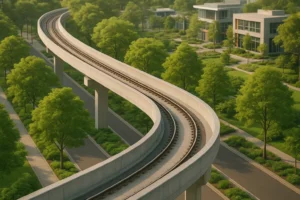America’s transportation network is the backbone of its economy, but it’s straining under the weight of multiple converging pressures. From the rising demand for electric vehicles and the energy they consume, to the chronic shortage of truck parking spaces, to aging infrastructure that can’t keep up with freight volumes, the challenges are broad and interconnected. Solving them will require innovation across sectors, collaboration between private and public players, and a willingness to rethink how we build for the future.
Electrification and Energy Costs
Electric vehicles are no longer just a consumer trend. Commercial fleets are starting to adopt EVs as governments and corporations push for lower emissions. But electrification is more than a matter of buying vehicles; it’s about understanding how, when, and where to power them.
Adam Cain of ElectricityRates.com points out that one of the biggest hurdles for EV adoption is cost predictability. “Electricity isn’t priced like gasoline,” he explains. “It varies by time of day, region, and utility structure. Fleet operators who don’t take advantage of time-of-use rates or competitive supply options could see their costs balloon unnecessarily.”
By shopping for the best plans and aligning charging schedules with off-peak hours, both consumers and fleets can dramatically reduce expenses while also easing strain on the grid. “The smarter we are about charging, the smoother the transition to electric transport will be,” Cain says.
The Truck Parking Shortage
While electrification gets most of the headlines, one of the industry’s longest-running crises is hiding in plain sight: the lack of safe, legal parking for truck drivers. The Federal Highway Administration estimates there are only about 697,000 parking spaces available nationwide for over 2 million long-haul truck drivers, a shortfall that forces drivers to park on highway shoulders, in abandoned lots, or miles away from their routes.
Evan Shelley, Co-Founder and CEO of Truck Parking Club, calls it one of the most overlooked choke points in America’s supply chain. “For every eleven trucks on the road, there’s only one available space,” Shelley notes. “Drivers waste nearly an hour every day just searching for parking, which costs them more than $5,000 a year in lost time and fuel. This is an economic drain – and a safety risk.”
Truck Parking Club has worked to bridge this gap by connecting drivers with underutilized private lots that can be instantly booked through its platform. “We’re proving that you don’t always need years of construction or millions in federal funding to create new capacity,” Shelley says. “With the right technology, we can put thousands of new spots on the map today.”
Infrastructure Under Pressure
Beyond parking and charging, the physical infrastructure that underpins America’s transit system is under increasing pressure. Freight volumes continue to rise, cities are growing denser, and roads built decades ago are showing their age. Public funding bills are helping, but private-sector innovation is increasingly filling the gaps.
Parking platforms like Truck Parking Club demonstrate how digital tools can unlock new supply without building new lots. At the same time, rate-comparison services like ElectricityRates.com show how better data can help both households and companies use energy more efficiently. Together, these innovations highlight a new reality: the future of transportation will depend not only on steel and concrete, but also on smarter systems.
Looking Ahead
The challenges facing American transportation can’t be solved in silos. Electrification without smart charging risks overloading the grid. Freight efficiency without safe parking continues to put drivers at risk. Infrastructure investment without private-sector innovation will struggle to keep pace with demand.
As Cain puts it, “Energy, infrastructure, and transportation are no longer separate conversations. They’re parts of the same equation.” Shelley agrees, adding that, “We need to recognize parking and logistics as essential infrastructure, because without them, the entire supply chain suffers.”
The road ahead will require bold ideas, nimble execution, and a willingness to connect the dots between problems that once seemed unrelated. The payoff is enormous: a transportation system that is safer, more efficient, and ready for the demands of tomorrow.







